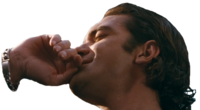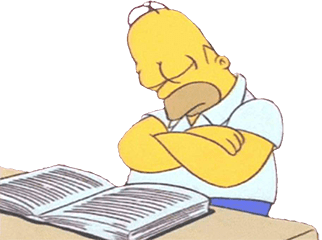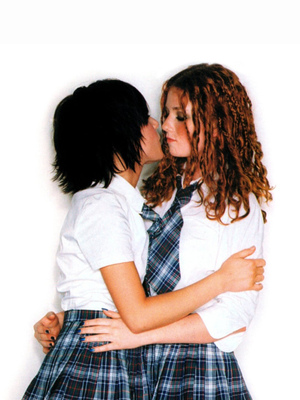 hayabusa 🌐Feb 25, 2024
hayabusa 🌐Feb 25, 2024
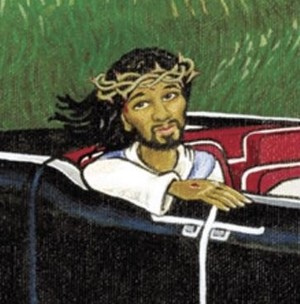 proper 🔩Feb 25, 2024
proper 🔩Feb 25, 2024the coloring in great pretender so good
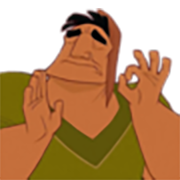
 proper
propermashle
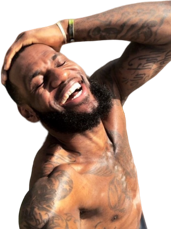
i knew they were connected but when that dude called mash his son...

need next ep expeditiously
 proper 🔩Feb 26, 2024·1 reply
proper 🔩Feb 26, 2024·1 reply Mictlan
Mictlan
what anime is this?
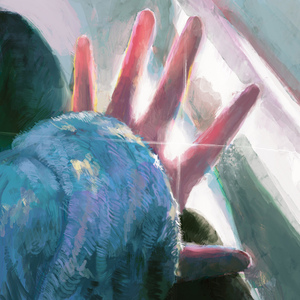 Jonz
JonzIs anyone familiar with Bloom Into You? Pretty cute
Goated yuri. Also love how it cinematic it can get. Those panels are quite something
Reminds me that I should check out the side story
All gifs in order
Metal Armor Dragonar (1987)
Fight Iczer 1 (1987)
Great Planet Evil-Destroyer Dangaioh (1987)
Bubblegum Crisis (1988) Presumed
Gunbuster (1989)
Tekkaman Blade (1992)
Magic Knight Rayearth (1994) first cut only, OP direction and SB too
Gaiking Legend of Daiku-Maryu (2005)
Mobile Suit Gundam Age (2012)
Gundam Build Fighters (2015)
Mobile Suit Gundam: Iron Blooded Orphans (2016)
Gundam Build Divers (2019) Presumed
King of Fighters XV CM (2022)
Mobile Suit Gundam: The Witch from Mercury (2023) second and third cuts only
Bang Brave Bang Bravern (2024) series direction only, animation presumably by Akira AmemiyaHappy Super Belated Birthday to Masami Obari born January 24th, 1966. A mecha god. Perhaps one of the most auspicious and recognizable mech animators ever for his pose heavy forms, and empowering drawings of metal titans. Coming into the mecha genre in the early to mid 80s Obari proved himself as a fresh minded newcomer, taking the sensibilities of Yoshinori Kanada and more closely one of his offspring Masahito Yamashita’s effects and devices to make a wholly original style of mecha animation. The Obari aesthetic can only be described as overtly masculine, and packing a ton of power. The foreshortening, bold poses, and sharp sense of giant-ness in detail with mecha designs made Obari a mega threat in the genre. From about 1985-1992 Obari was one of the most consistent and daring heavy mechanical animators ever, even leading him for series robot designs and direction. By the mid 90s Obari had transitioned away from mecha and into super human action like Fatal Fury and Gowcaizer with him in the director’s chair. The 2000s still had Obari producing mecha and his heart has been in the genre ever since he started animating. He’s been on a numerous amount of Brave anime, and Gundam to which he more recently started animating for the franchise in the 2010s. Time to cover the maniacal king of mecha himself, Masami Obari.
“Believe it or not, I didn’t know anything about anime or the industry until I entered high school. I didn’t really watch anime as a young kid. It was in high school that I was actually exposed to it for the first time. At the time I wanted to do something like interior design and so entered a school known for that. It just so happened that the person that sat next to me was Satoshi Urushihara*.”
When taking classes at Hiroshima Prefectural Miyajima Technical High School, Urishihara introduced Obari to a ton of mecha shows even familiarizing him with Yoshinori Kanada, the most famed mecha animator at the time learning about classics the man worked on like Daitarn 3 and Commander Nero’s Challenge. Obari and Urishihara were not the only two future sakuga lords attending the school, coincidentally future J.C. Staff director and animator Katsushi Sakurabai and freelancer Yoshitaka Kouno both sat in the same room. During school Obari quickly began to send his drawings to Tatsunoko Productions and Kaname Pro just to have a handle on getting connections.
“At the time there were a lot of ‘star animators’ weren’t there? People like Kanada and Kazuhiro Ochi. I really admired Ochi when he was young and at the height of his ability. Knowing that Ochi was not only doing key animation work but directing episodes and drawing storyboards when he was just 20 years old, I felt like I had to hurry too. I felt like that in this industry you’ve got to run to the top fast. So I thought that rather than taking it easy and going to school, I needed to get into a studio as soon as possible. I was sure it would be difficult but I didn’t hesitate or think twice about it at all.”
During free time Obari was constantly drawing, and before his mecha days he was getting into drawing people, which is extremely unusual for someone so coveted in covering the mecha medium.
Obari’s first known credited work was in-between animation on Powered Armor Dorvack, Sei Juushi Bismarck, Captain Tsubasa, and Megazone 23. His debut as not only a key animator, but joint mecha designer alongside future Gundam Seed CD Hisashi Hirai was on Dancouga: Super Beast Machine God at Ashi Productions


Created by Yuuichi Hasegawa and directed and CAD’d by the legendary Seiji Okuda a veteran of the industry getting his start back since the dawn of tv anime, Dancouga was a promising introduction to a then 19 year old Masami Obari. Obari while ostensively excited for the series was pretty limited in what he could do with designs, since the TV format was less forgiving with details (an aspect of design he wanted to explore further) he and Hirai could not go above the amount of line work they wanted. Thanks to Ashi’s team Obari got to work with legends throughout the show. Obari made his KA debut on Episode 5, though there are no sources (yet) for his animation here he was luckily accompanied by Birth alumni Hideki Tamura and Shinsaku Kozuma, two 6 year older seniors who likely showed him the ropes. Of his many appearances throughout the show Obari’s animation is surprisingly fast paced, unlike the usual Kanada/Yamashita influenced guys at the time he was able to get in a lot of drawings while still sticking to a conservative line count. Episode 39, is significant due to it being the first time we see a classic Obari boss pose
Lets talk designs
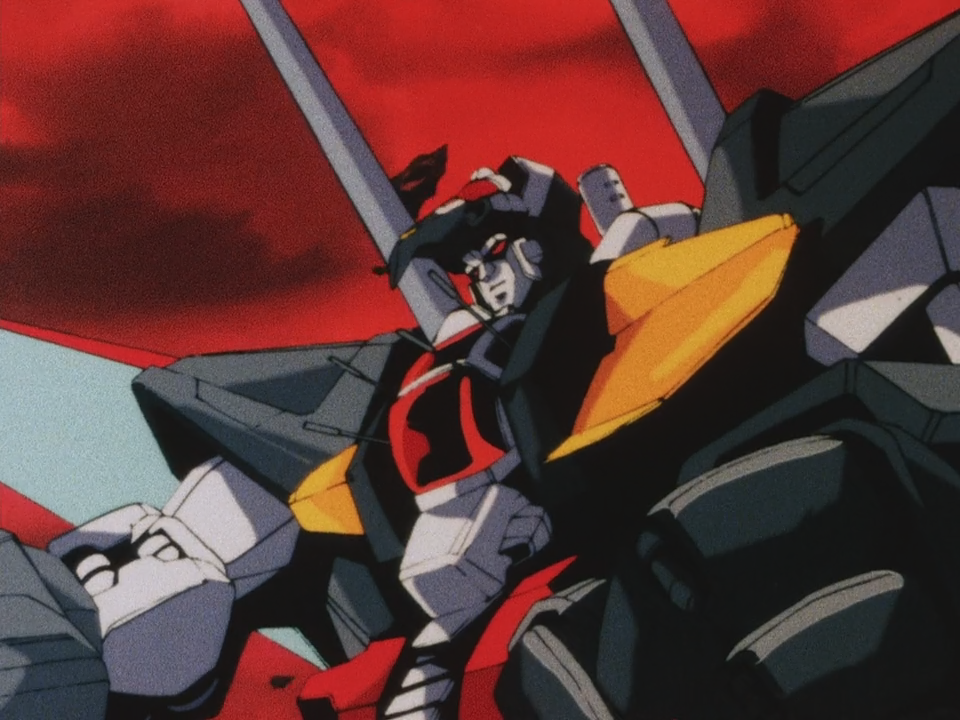

At the time placing an absurd amount of detail into the mecha designs wasn’t the norm unless it was the case for OVA’s but as the tides turned and Wakame Shadows came about with Yamashita, Obari hopped on the trend occasionally adding needed shading when he could.
It is a hassle to add that much shading, but the designs look more polished as a result. The influence of Transformers was also apparent, which Obari would shortly become and animation director for them too.The next year Obari would work on the last episodes on Ninja Robot Tobikage, and while he would not cross paths with some of the animators, a handful of the future Five Masters of Realism Hiroyuki Okiura, Mitsuo Iso, and Shinya Ohira all were working on the show at the time. Ohira would cross paths with Obari a little later.
After a Dancouga OVA and working on MD Geist, Transformers and Machine Robo, Obari would have his biggest rise to fame yet on the opening for Metal Armor Dragonar where he was one of the sole animators and MAD (mechanical animation director)

“…Sunrise robot anime OPs created by the senior animators around me had a really strong brand image, so I felt like I had to try something different. Kanada’s Daitarn 3 OP was one example, along with Kazuaki Moori and Toru Yoshida’s Blue Comet SPT Layzner* OP, as well as Yasuomi Umetsu’s Mobile Suit Zeta Gundam OP. These are names you think of as soon as you imagine an opening. Before any thoughts of winning or competing with these, working on the Dragonar OP seemed like the best tool just to grab attention. I also wanted to do something different from what had been done up until then. Lucky for me the producer at the time, Takayuki Yoshii, left it all up to me (laughs).”
Excelling in the elements mentioned above, Obari went to the stars in this sweeping and showy metal dream of robot fighters in motion. Obari was extensive in storyboard control and detail, even dangerously correcting board changes made by the director, doing as much he can to show off his abilities. Anime fans who took notice of Obari’s name gave the OP the title of “Barigner” as play on words with the lyrics in the opening.
In the final episode of Fight! Iczer One Masami Obari was allowed free reign over the mecha designs in the opening fight


Timestamp 56:20-1:02:16 Obari mostly mecha and effects cuts only
At just 21 years old Obari did nearly 80 cuts for the battle sequence here, and pours every single ounce of his soul into the some of the most badass mecha designs ever. Some how enabled with a more magical complex, these aren’t your usual brick boys from Transformers or other series, no, the mecha Iczer Robo and Iczer Sigma are sharp jagged and resemble closer relations to kaiju then robots. Bari juxtaposes his slower motion by big fast windups on 1s, and uses sensational drawings to give the scene gravity, weight, and scale.This scene is also synonymous with the invention of a mecha staple, something that has been used in mecha show, the famous Obari Punch, this being the famous first instance of one.
An Obari Punch consists of a few simple elements that give it that flare described by sakugabooru user Kraker2k“There are roughly 3-4 poses which define this type of punch.
There is the initial pose -> pull back of arm -> thrusting chest out and head tilted - > thrusting the hand/arm forward and punching towards the screen.”As seen here








and from this moment on it became a widely adopted trait, chiefly among super robot series and often Gainax and Trigger showsThe next anime would be another galaxy sized step into OVA mecha action, and designs for Obari on Great Planet Evil-Destroyer Dangaioh


Solo KA OP by Obari’s idol Masahito Yamashita
Directed by future modern Baki director Toshiki Hirano, this super powered psychic robot anime is one of the greatest showcases of Obari’s design traits up to this point. Even before getting into the animation or anything like that, the immediate thing that stands out instantly is Dangaioh itself.
While no doubt a mecha, Obari was incredibly ahead of his time giving a interesting blend of humanoid elements into the mecha designs, but much like Iczer having the sleekness and almost hybridized kaiju element that is difficult to pin down. However there is something that he does in the brain that activates a strong sense of satisfaction, and this is also an extreme case of him significantly altering the original design sheets
Obari brings the heat in this show, within the entire opening episode itself which again like Iczer is a phenomenal display of classic Obari action.

Obari 4:43-9:39
For 5 minutes the entire Obari aesthetic is on full-tilt display with Obari plainly just showing not how awesome his drawings are, but the oozing swagger and dominion he already had over the mecha genre at such a young age. The scene is rife with insane craftsmanship.







A ton of other animators draw Dangaioh, like Yamashita, Ochi, Shin Matsuo, and Shoichi Masuo but none touch the level of on model clarity that Obari held.The next big sized project would be Obari making his directorial debut on Episode 5, and 6 of Bubblegum Crisis after getting recognition from his work on Dangaioh

Taking over from Katsuhiro Akiyama in the direction department and Shinya Ohira and Masahito Yamashita in the animation department, Obari directing at such a young age was largely unprecedented. As for getting the job done, he was perfect for the job. For both episodes he was a bit of an unusual choice since this was leaning into a more stringent theme of realistic action, and direction. While the dialogue was as crazy as can be, some of the touches were unusual for him as being very grounded. Obari was still able to keep up with his classic mecha match cuts, and also very detailed designs. While lacking some of the fluidity that Ohira, and the other team had it still looked just as good. One familiar animator who would become a close knit associate Masahiro Yamane.After a myriad of other projects including, Gall Force 2: Destruction, Metal Skin Panic, and Project A-Ko!, Obari would do his only work for Gainax on one of their earliest flagship OVAs Gunbuster, directed by Hideaki Anno


Obari 0:18-0:27
Not much is known why Obari never got back to working at one of the more exciting new studios at the time, but this scene exemplifies every perfect thing about Obari. His empowering depth of the Kamen Rider style kick in Gunbuster feels so realized and personal here, and in several seconds is able to convey the strong and heroic Gainaxing we all know and love.Now we enter the 90s, probably the most difficult area of Obari’s career to cover in full. Without going over every single thing, it is better for me to elaborate on the significant moments of this decade, and the number of connections, and animators that he influenced or worked with. As midway through the decade he’d bloom as a phenomenal OVA director.

